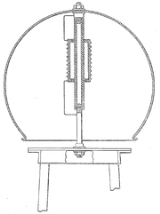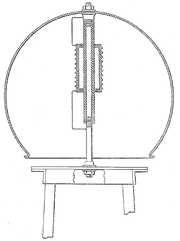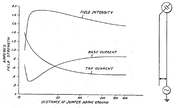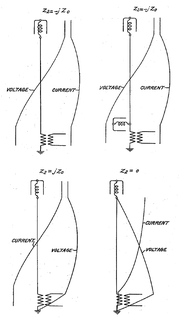
Electrical lengthening
Encyclopedia
Electrical lengthening is the modification of an aerial
which is shorter than a whole-number multiple of a quarter of the radiated
wavelength
, by means of a suitable electronic device, without changing the physical length of the aerial, in such a way that it corresponds electrically to the next whole-number multiple of a quarter of the used wavelength. A lengthening is only possible to the next whole-number multiple of a quarter of the radiated wavelength.
Thus an aerial with a length corresponding to the eighth of the radiated wavelength can be extended only to a quarter-wave radiator
, but not to a half wave radiator.



and medium-wave transmitter
s, because mast
radiators of the necessary height cannot be realised economically.
control measures are not undertaken. An electrically extended aerial is less efficient than a non-extended antenna.
Often both measures are combined. The coils switched in series must be sometimes be placed in the middle of the aerial construction. The cabin installed at a height of 150-metres on the Blosenbergturm
in Beromünster
is such a construction, in which a lengthening coil is installed for the supply of the upper tower part (the Blosenbergturm has in addition a ring-shaped roof capacitor on its top)
s electrical lengthening is extensively applied, because these use antennas which are considerably less tall then a quarter of the radiated wavelength.
Antenna (radio)
An antenna is an electrical device which converts electric currents into radio waves, and vice versa. It is usually used with a radio transmitter or radio receiver...
which is shorter than a whole-number multiple of a quarter of the radiated
Electromagnetic radiation
Electromagnetic radiation is a form of energy that exhibits wave-like behavior as it travels through space...
wavelength
Wavelength
In physics, the wavelength of a sinusoidal wave is the spatial period of the wave—the distance over which the wave's shape repeats.It is usually determined by considering the distance between consecutive corresponding points of the same phase, such as crests, troughs, or zero crossings, and is a...
, by means of a suitable electronic device, without changing the physical length of the aerial, in such a way that it corresponds electrically to the next whole-number multiple of a quarter of the used wavelength. A lengthening is only possible to the next whole-number multiple of a quarter of the radiated wavelength.
Thus an aerial with a length corresponding to the eighth of the radiated wavelength can be extended only to a quarter-wave radiator
Dipole antenna
A dipole antenna is a radio antenna that can be made of a simple wire, with a center-fed driven element. It consists of two metal conductors of rod or wire, oriented parallel and collinear with each other , with a small space between them. The radio frequency voltage is applied to the antenna at...
, but not to a half wave radiator.



Advantages
The electrical lengthening allows the construction of shorter aerials. It is applied in particular for aerials for VLF, longwaveLongwave
In radio, longwave refers to parts of radio spectrum with relatively long wavelengths. The term is a historic one dating from the early 20th century, when the radio spectrum was considered to consist of long, medium and short wavelengths...
and medium-wave transmitter
Transmitter
In electronics and telecommunications a transmitter or radio transmitter is an electronic device which, with the aid of an antenna, produces radio waves. The transmitter itself generates a radio frequency alternating current, which is applied to the antenna. When excited by this alternating...
s, because mast
Radio masts and towers
Radio masts and towers are, typically, tall structures designed to support antennas for telecommunications and broadcasting, including television. They are among the tallest man-made structures...
radiators of the necessary height cannot be realised economically.
Disadvantages
The electrical lengthening reduces the bandwidth of the antenna if other phasePhase (waves)
Phase in waves is the fraction of a wave cycle which has elapsed relative to an arbitrary point.-Formula:The phase of an oscillation or wave refers to a sinusoidal function such as the following:...
control measures are not undertaken. An electrically extended aerial is less efficient than a non-extended antenna.
Technical realization
There are two possibilities for the realisation of the electric lengthening.- switching in inductive coilsInductorAn inductor is a passive two-terminal electrical component used to store energy in a magnetic field. An inductor's ability to store magnetic energy is measured by its inductance, in units of henries...
in seriesSeries and parallel circuitsComponents of an electrical circuit or electronic circuit can be connected in many different ways. The two simplest of these are called series and parallel and occur very frequently. Components connected in series are connected along a single path, so the same current flows through all of the...
with the aerial - switching in metal surfaces, known as roof capacitance, at the aerial ends which form capacitorCapacitorA capacitor is a passive two-terminal electrical component used to store energy in an electric field. The forms of practical capacitors vary widely, but all contain at least two electrical conductors separated by a dielectric ; for example, one common construction consists of metal foils separated...
s to earthGround (electricity)In electrical engineering, ground or earth may be the reference point in an electrical circuit from which other voltages are measured, or a common return path for electric current, or a direct physical connection to the Earth....
.
Often both measures are combined. The coils switched in series must be sometimes be placed in the middle of the aerial construction. The cabin installed at a height of 150-metres on the Blosenbergturm
Blosenbergturm
The Blosenbergturm is a transmitting tower in Beromünster, Canton of Lucerne, Switzerland, built in 1937 for the German language radio station DRS and radiating at an AM frequency of 531 kHz marking the bottom end of the official mediumwave broadcasting range. The Blosenbergturm has a height of...
in Beromünster
Beromünster
Beromünster is a municipality in the district of Sursee in the canton of Lucerne in Switzerland. On 1 January 2009 Gunzwil became part of Beromünster.-History:...
is such a construction, in which a lengthening coil is installed for the supply of the upper tower part (the Blosenbergturm has in addition a ring-shaped roof capacitor on its top)
Application
Transmission aerials of transmitters working at frequencies below the longwave broadcasting band always apply electric lengthening. Broadcasting aerials of longwave broadcasting stations apply it often. However, for transmission aerials of NDBNon-directional beacon
A non-directional beacon is a radio transmitter at a known location, used as an aviation or marine navigational aid. As the name implies, the signal transmitted does not include inherent directional information, in contrast to other navigational aids such as low frequency radio range, VHF...
s electrical lengthening is extensively applied, because these use antennas which are considerably less tall then a quarter of the radiated wavelength.
See also
- Electrical shortening
- Loading coilLoading coilIn electronics, a loading coil or load coil is a coil that does not provide coupling to any other circuit, but is inserted in a circuit to increase its inductance. The need was discovered by Oliver Heaviside in studying the disappointing slow speed of the Transatlantic telegraph cable...
- Antenna tunerAntenna tunerAn antenna tuner, transmatch or antenna tuning unit is a device connected between a radio transmitter or receiver and its antenna to improve the efficiency of the power transfer between them by matching the impedance of the equipment to the antenna...
- Monopole antennaMonopole antennaA monopole antenna is a class of radio antenna consisting of a straight rod-shaped conductor, often mounted perpendicularly over some type of conductive surface, called a ground plane. The driving signal from the transmitter is applied, or for receiving antennas the output voltage is taken,...
Further reading and references
- A. Nickle, , "Antenna". (Filed May 25, 1934; Issued Aug 2, 1938)
- William W. Brown, , "Antenna structure". (Filed May 25, 1934; Issued Oct 27, 1936).
- Robert B. Dome, , "Antenna". (Filed May 25, 1934; Issued Dec 7, 1937)

